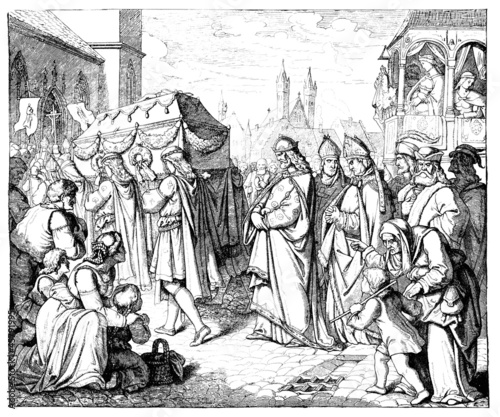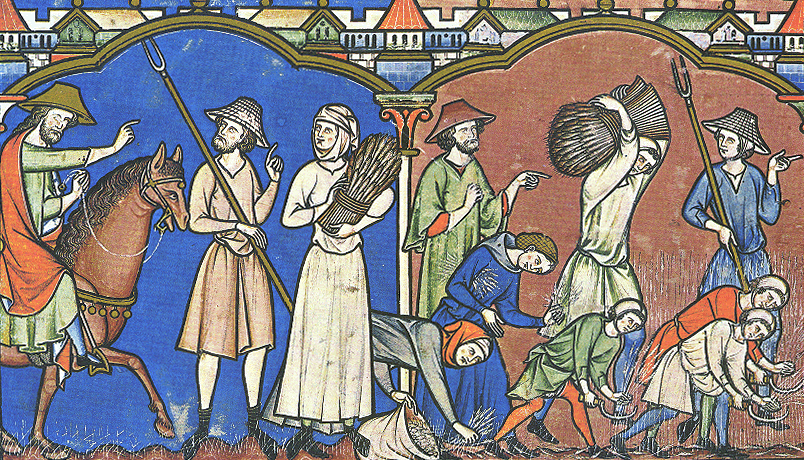In Medieval times before the advent of the printing press most people relied on images in illustration, illuminated manuscript, and stained glass to visualize and communicate what is contained in written text. The illiterate and to those without access to copies of the source text had to rely on these visual interpretations to ascertain the truth. This is very similar to today's use of data visualization tools and infographics to help those who either are not good with numbers or who don't have access to the raw data to ascertain the truth. Each medium has a different set of affordances and range of expression. Information gained from an image contains information not gained from text or numbers. There are also limits to what visual representation can tell us.
When we rely on visual interpretations to understand data, how can we be sure what we are seeing is not a distortion of the truth? How can we be sure we are not missing something important? How can we be sure we really understand the data?
 |  |
 | |
 |  |
There is an old Hindu saying associated with the elephant-headed god Ganesh that says, "map is not territory" meaning that a map is an abstraction. It represents territory but is not itself the thing it depicts. René Magritte addressed this concept in his famous painting "The Treachery of Images" in 1928-1929. Below it, Magritte painted, "Ceci n'est pas une pipe" for "this is not a pipe." It certainly is not, it is a painting, an abstract representation of a pipe. There are many who have observed the abstract nature of a representational medium. The same is true with the written word.
In Medieval times very few people were privileged enough to either possess books or learn to read, that was reserved for clergy and those in power (kings, queens, noblemen, lords, etc.). The average peasant read pictures but the ultimate statement of truth was, "and so it is written." Today we say there is "truth in numbers" for the same exact reason. Phrases like, "research shows," or "polls indicate," or "according to statistics" carry the same weight and are used in exactly the same way people used to refer to the written word. And the reason for this is, with the exception of the privileged few who have both access to the sources of data we hear used on a daily basis to support this or that claim and who have the skill to read and interpret it, for most of us the raw data is just as much a mystery as the written word was to the average Medieval peasant.
Both written language and statistics are abstractions from the truth. The most common texts in Medieval times were religious texts and were regarded as having been delivered to mankind through the hand of God himself. Yet historically, we know the Bible is a collection of many books that once were separate and only came together when a Roman emperor (Constantine) called for church leaders to canonize some of the books so that he could use the Roman Catholic Church to unify a wavering Roman Empire. After the Council of Nicaea the written word was translated into Latin then used as a political tool to manipulate the public.
The New Testament books, and the ones that were left out of the cannon, were written by men (and some women) and most were historical accounts of the life of Jesus Christ. These documents are essentially abstractions. The book of Matthew is not the life of Jesus Christ but one man's written depiction rendered in the abstraction that is the written word. By Medieval times most people no longer spoke Latin yet churches insisted on conducting services in that language leaving hem to rely on visual interpretations of a Latin text that had already been translated once, whose original was, by the very nature of the medium, an abstraction from the reality of the content the original was trying to depict. With each translation and with each interpretation into a new medium there presents the opportunity to alter or distort the original message. In this time the church used the written word the same way Emperor Constantine used it...for social and political control and manipulation.
Today data is used with the same power and for the same purposes. Data is collected by those who wish to exact some influence or control over that which it is being collected on. Much like the selection of books at the Council of Nicaea, data becomes canonized by those who wish to use it to control or manipulate. We put faith in numbers because like the written word to the Medieval peasant we find raw data to be largely inaccessible but also magical. But, just a written account of the life of Jesus Christ is not the same thing as the actual life of Jesus Christ, and just as a map is not territory, I am not the sum of my data. The world represented through statistics is a make-believe world, an abstraction. And statistics interpreted visually are even further removed from the truth.











6 comments:
what a great post! thank you! )
Best Essay Writing Services
Custom Essay Writing Professional USA
Research Paper Writing Help
College essay writing service
I am al so agree with all above comments.. thanks for it!
Creative Writing Service Online
Thanks so much for the impressive and amazing guide
cheap essay writing service
term paper writing service
research paper writing service
custom essay writing service
Interesting information. Thanks for sharing this.
Time Attendance Machine Pakistan
Time Attendance Machine Karachi
Time Attendance Machine in Karachi
Data is the gold of the 21st Century of AI, Machine Learning, and Data Science.
By the way, we PAK Communications is based on the simple idea of bringing emerging technologies as per business needs. We are security CCTV Camera in Karachi, surveillance and communication solutions provider to business and home consumers.
Fire Alarm is designed to alert us to an emergency so that we can take action to protect ourselves, staff, and the general public. there is an emergency at which point, they might just save our lives. ASN systems (Active Security and Network Systems) provides the best, quick detecting Fire Alarm in Karachi.
https://asnsystem.pk/fire-alarm-system.html
Post a Comment